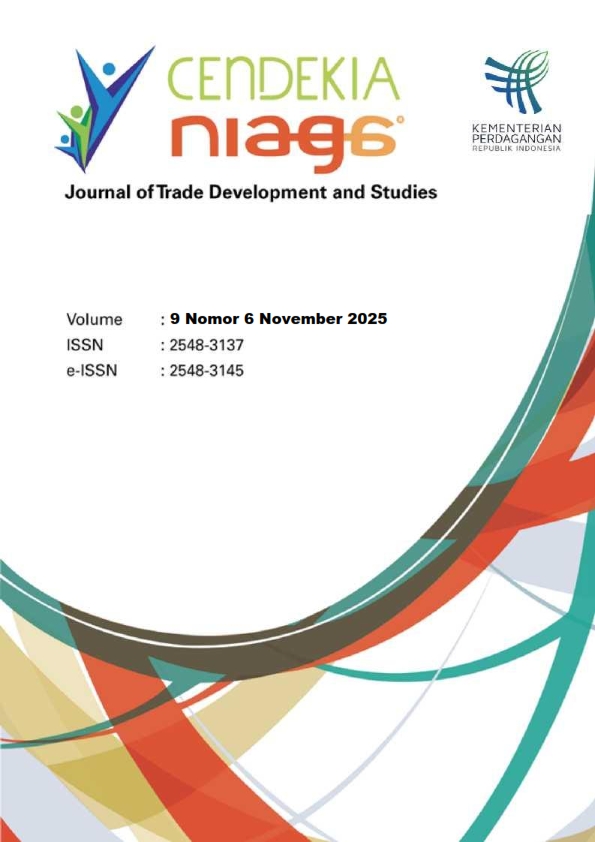Revisiting The Impact of Trade Openness and FDI on CO2 Emissions: Evidence from ASEAN-China FTA Countries
Main Article Content
Abstract
Article Details

This work is licensed under a Creative Commons Attribution-ShareAlike 4.0 International License.
References
Ahmed, K., Rehman, M. U., & Ozturk, I. (2017). What drives carbon dioxide emissions in the long-run? Evidence from selected South Asian Countries. Renewable and Sustainable Energy Reviews. Elsevier Ltd. https://doi.org/10.1016/j.rser.2016.12.018
Alvi, S., Chaudhry, I., Farooq, F., & Safdar, N. (2019). Trade liberalization, foreign direct investment inflows, environmental quality and economic growth nexus: a comparative analysis of pakistan and china. Review of Applied Management and Social Sciences, 2(1), 17-26. https://doi.org/10.47067/ramss.v2i1.11
Bayar, İ. and Dabakoğlu, M. (2024). How do economic growth, trade openness, and non-renewable and renewable energy affect environmental quality in vista countries?. Economic Journal of Emerging Markets, 63-76. https://doi.org/10.20885/ejem.vol16.iss1.art6
Dietz, T., Rosa, E.A., 1997. Effects of population and affluence on CO2 emissions. P. Natl. Acad. Sci. 94, 175–179. https://doi.org/10.1073/pnas.94.1.175.
Dogan, E., & Turkekul, B. (2016). CO2 emissions, real output, energy consumption, trade, urbanization and financial development: testing the EKC hypothesis for the USA. Environmental Science and Pollution Research, 23(2), 1203–1213. https://doi.org/10.1007/s11356-015-5323-8
Dou, Y., Zhao, J., Malik, M. N., & Dong, K. (2021). Assessing the impact of trade openness on CO2 emissions: Evidence from China-Japan-ROK FTA countries. Journal of Environmental Management, 296. https://doi.org/10.1016/j.jenvman.2021.113241
Eddine Chebbi, H., Olarreaga, M., & Zitouna, H. (2011). Trade Openness and Co 2 Emissions in Tunisia. Middle East Development Journal, 3(1), 29–53. https://doi.org/10.1142/s1793812011000314
Fang, J., Gozgor, G., Lu, Z., & Wu, W. (2019). Effects of the export product quality on carbon dioxide emissions: evidence from developing economies. Environmental Science and Pollution Research, 26(12), 12181–12193. https://doi.org/10.1007/s11356-019-04513-7
Gözgör, G. (2017). Does trade matter for carbon emissions in oecd countries? evidence from a new trade openness measure. Environmental Science and Pollution Research, 24(36), 27813-27821. https://doi.org/10.1007/s11356-017-0361-z
Hu, X., Pollitt, H., Pirie, J., Mercure, J., Liu, J., Meng, J., … & Tao, S. (2020). The impacts of the trade liberalization of environmental goods on power system and co2 emissions. Energy Policy, 140, 111173. https://doi.org/10.1016/j.enpol.2019.111173
Lv, Z., & Xu, T. (2019). Trade openness, urbanization and CO 2 emissions: Dynamic panel data analysis of middle-income countries. Journal of International Trade and Economic Development, 28(3), 317–330. https://doi.org/10.1080/09638199.2018.1534878
Mahmood, H., Maalel, N., & Zarrad, O. (2019). Trade openness and co2 emissions: evidence from tunisia. Sustainability, 11(12), 3295. https://doi.org/10.3390/su11123295
Meng, C., Li, D., Jin, J., & Cui, L. (2023). The carbon footprint of global trade: assessing the impact of trade liberalization on the carbon emissions of chinese listed companies. Natural Resources Forum, 48(4), 1371-1391. https://doi.org/10.1111/1477-8947.12371
Nurgazina, Z., Ullah, A., Ali, U., Koondhar, M., & Lu, Q. (2021). The impact of economic growth, energy consumption, trade openness, and financial development on carbon emissions: empirical evidence from malaysia. Environmental Science and Pollution Research, 28(42), 60195-60208. https://doi.org/10.1007/s11356-021-14930-2
Prasetyo, A. and Susandika, M. (2022). FDI led growth hypothesis and export led growth hypothesis in ASEAN. E-Journal Ekonomi Bisnis Dan Akuntansi, 9(2), 88. https://doi.org/10.19184/ejeba.v9i2.31602
Safdar, N., Ghaffar, H., Farooq, F., & Liaquat, M. (2020). Trade liberalization, economic growth and environmental quality nexus: an empirical evidence from pakistan. Review of Education Administration and Law, 3(3). https://doi.org/10.47067/real.v3i3.92
Shahbaz, M., Gozgor, G., Adom, P. K., & Hammoudeh, S. (2019). The technical decomposition of carbon emissions and the concerns about FDI and trade openness effects in the United States. International Economics, 159, 56–73. https://doi.org/10.1016/j.inteco.2019.05.001
Shahbaz, M., Solarin, S. A., & Ozturk, I. (2016). Environmental Kuznets Curve hypothesis and the role of globalization in selected African countries. Ecological Indicators, 67, 623–636. https://doi.org/10.1016/j.ecolind.2016.03.024
Shahbaz, M., Nasreen, S., Ahmed, K., & Hammoudeh, S. (2017). Trade openness–carbon emissions nexus: the importance of turning points of trade openness for country panels. Energy Economics, 61, 221-232. https://doi.org/10.1016/j.eneco.2016.11.008
Shahzad, S. J. H., Kumar, R. R., Zakaria, M., & Hurr, M. (2017, April 1). Carbon emission, energy consumption, trade openness and financial development in Pakistan: A revisit. Renewable and Sustainable Energy Reviews. Elsevier Ltd. https://doi.org/10.1016/j.rser.2016.11.042
Shakil, M. (2020). Environmental, social and governance performance and stock price volatility: a moderating role of firm size. Journal of Public Affairs, 22(3). https://doi.org/10.1002/pa.2574
Shuquan, H. (2019). Competition among china and asean-5 in the us market: a new extension to shift-share analysis. Socioeconomic Challenges, 3(4), 129-137. https://doi.org/10.21272/sec.3(4).129-137.2019
Wang, Q., Wang, L., & Li, R. (2023). Trade openness helps move towards carbon neutrality—insight from 114 countries. Sustainable Development. https://doi.org/10.1002/sd.2720
Wang, R. (2023). Trade liberalization and carbon neutralization: a quasi-natural experiment based on china-asean free trade area. Journal of World Economy, 2(2), 33-41. https://doi.org/10.56397/jwe.2023.06.03
Widyawati, R., Hariani, E., Ginting, A., & Mufida, Z. (2021). Effect of economic growth, urban population, trade openness on carbon dioxide emissions in asean-5. Proceeding of the International Seminar on Business Economics Social Science and Technology (Isbest), 1. https://doi.org/10.33830/isbest.v1i.612
Xiang, L., Chen, X., Shu-ling, S., & Yin, Z. (2021). Time-varying impact of economic growth on carbon emission in brics countries: new evidence from wavelet analysis. Frontiers in Environmental Science, 9. https://doi.org/10.3389/fenvs.2021.715149
Zhao, C., Sun, J., Gong, Y., Li, Z., & Zhou, P. (2022). Research on the blue carbon trading market system under blockchain technology. Energies, 15(9), 3134. https://doi.org/10.3390/en15093134
